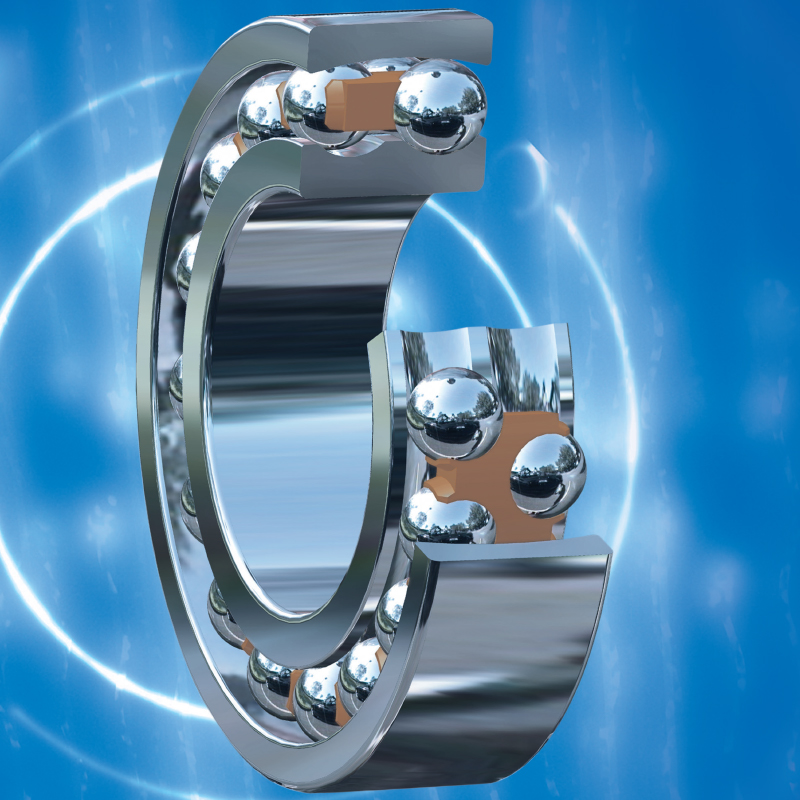SẢN PHẨM
Năng lực R&D sản phẩm hàng đầu

VÒNG BI CẦU HAI DÃY TỰ LỰA – VÒNG BI NHÀO
HRB self-aligning ball bearings have two rows of balls, a spherical raceway in the outer ring and two raceways in the inner ring. During normal running, the bearing may allow a certain deflection of the balls, cage and inner ring relative to the outer ring, i.e. having self-aligning ability which can obtain self-adapting for shaft offsets or housing deformation resulting from machining or assembling, if the deflection of the inner ring relative to the outer ring is within 3o.
These bearings are mostly used to carry radial loads and can also accommodate a certain amount of simultaneously acting axial loads, not including purely axial loads.
Self-aligning bearings are basic design and sealed design.
Basic design
These bearings are available with cylindrical or tapered bore, the later of a bore taper 1:12. The self-aligning ball bearings with tapered bore can be mounted either directly on a tapered shaft or on a cylindrical shaft using adapter sleeve or withdrawal sleeve. With the help of the adapter sleeve, the bearing internal radial clearance is also to be adjusted.
HRB self-aligning ball bearings with basic design have been modified in internal structure to a chieve more load capacity than the old ones. Consequently they have more applications, that is the bearing of the same size can carry heavies loads, or with the same loads the bearing reliability and life can be improved.
Sealed self-aligning ball bearings
HRB sealed self-aligning ball bearings have rubbing seals of suffix 2RS or 2RS1 on two sides, made of synthetic rubber and reinforced with steel insert. For such bearings, lubrication for life is adopted, i.e. maintenance is not required, neither heat nor wash before mounting.
Dimensions
The boundary dimension of self-aligning ball bearings given in the bearing tables are in conformity with ISO15-1981.
Angular misalignment
Self-aligning ball bearings are designed to compensate for a slight allowable angular misalignment between the inner and outer rings.
Values for allowable angular misalignment under normal running conditions are given in the following table. Subject to the bearing arrangement, seal type and so on, the values would be allowed.
| Bearings | Allowable angular misalignment (°) |
| 12 | 2.5 |
| 13 | 3 |
| 22 | 2.5 |
| 22-2RS | 1.5 |
| 23 | 3 |
| 23-2RS | 1.5 |
Tolerances
HRB self-aligning ball bearings are machined to normal tolerances, And the precision products of P6 and P5 tolerances are also available. Tolerance values can be obtained from the table of relevant class tolerances for radial bearings.
Radial internal clearance
Standard self-aligning ball bearings are supplied with normal radial internal clearance. The bearings with tapered bore are available with C3 as standard clearance. According to customer’s requirement, the bearings with radial internal clearance is greater or less than the standard clearance can also be supplied. Values for radial internal clearance are given in the table of radial internal clearance of self-aligning ball bearings.
Cages
Self-aligning ball bearings are accompanied with the cage of fiber glass reinforced nylon 66 as standard one, suffix TN. Such cages made of the above material have many advantages up to +120oC.
For very higher temperature and severe service conditions, pressed cages of steel or machined cages of brass have to be used. When the bearings incorporate non-standard cage, get in touch with HRB technology department.
Minimum rolling bearing load
In order to keep proper running of ball or roller bearings, the minimum required loads have to act on them including self-aligning ball bearings, or else during high speed running the mass forces of the balls and cage and the inadequate lubricant resistance may generate a harmful sliding between the balls and raceways, easy to lead to bearing damage.
Considering such a situation, the minimum required load is estimated from the equation:
Frm = kr(γn/1000)2/3(dm/100)2
where:
Frm— minimum radial load, N
kr— minimum radial load factor
=40, for 12 or 13 series bearings
=45, for 22 series bearings
=50, for 23 series bearings
γ— kinematic viscosity of oil at operating temperature, mm2/s
n—bearing speed, r/min
dm—bearing mean diameter=0.5(d+D), mm
In general the bearing supporting weight adding the external forces always goes beyond the minimum required load. If not, an additional load has to be exerted, for example, increasing belt tension and so on.
Equivalent dynamic bearing load
P = Fr + Y1Fa [kN], for Fa/Fr ≤ e
P = 0.65Fr + Y2Fa [kN], for Fa/Fr > e
Values for Y1, Y2 and e are listed in relevant bearing tables.
Equivalent static bearing load
P = Fr + Y0Fa (kN)
Values for Y0 are listed in relevant bearing tables
CATALOG HRB – VÒNG BI CẦU HAI DÃY TỰ LỰA